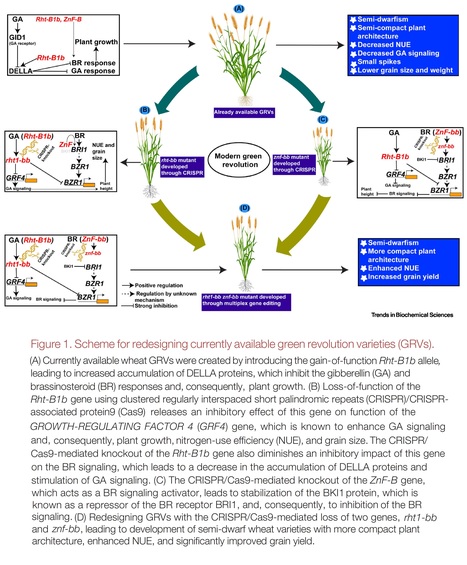Authors: Ming-Yi Bai, Jinrong Peng, and Xiangdong Fu.
Chinese Bulletin of Botany (2023)
Abstract: Since the 1960s, the utilization of semi-dwarfing genes Rht-B1b and Rht-D1b has significantly improved the lodging resistance and harvest index of wheat (Triticum aestivum), leading to a doubling of global wheat production and triggering the “Green Revolution” in agriculture. Rht-B1b and Rht-D1b encode plant growth-inhibiting factors, DELLA proteins, which are negative regulatory factors in the gibberellin (GA) signaling pathway. Accumulation of DELLA proteins not only inhibits cell division and elongation, leading to a dwarf phenotype, but also suppresses photosynthesis and nitrogen use efficiency, resulting in semi-dwarf varieties requiring higher fertilizer inputs to achieve high yields. Addressing the challenge of “reducing fertilizer inputs while increasing efficiency” is a crucial issue for achieving green and low-carbon agriculture. Recently, Zhongfu Ni and his colleagues from China Agricultural University identified a novel “semi-dwarfing” regulatory module with potential breeding applications and demonstrated that reducing brassinosteroid (BR) signaling could enhance grain yield of wheat “Green Revolution” varieties (GRVs). They isolated and characterized a major QTL responsible for plant height and 1000-grain weight in wheat. Positional cloning and functional analysis revealed that this QTL was associated with a ~500 kb fragment deletion in the Heng597 genome, designated as r-e-z, which contains Rht-B1 and ZnF-B (encoding a RING E3 ligase). ZnF-B was found to positively regulate BR signaling by triggering the degradation of BR signaling repressor BRI1 Kinase Inhibitor (TaBKI1). Further experiments showed that deletion of ZnF-B not only caused the semi-dwarf phenotypes in the absence of Rht-B1b and Rht-D1b alleles, but also enhanced grain yield at low nitrogen fertilization levels. Thus, manipulation of GA and BR signaling provides a new breeding strategy to improve grain yield and nitrogen use efficiency of wheat GRVs without affecting beneficial semi-dwarfism, which will drive toward a new “Green Revolution” in wheat.



 Your new post is loading...
Your new post is loading...










